
by Meghan Miner Thursday, June 7, 2018
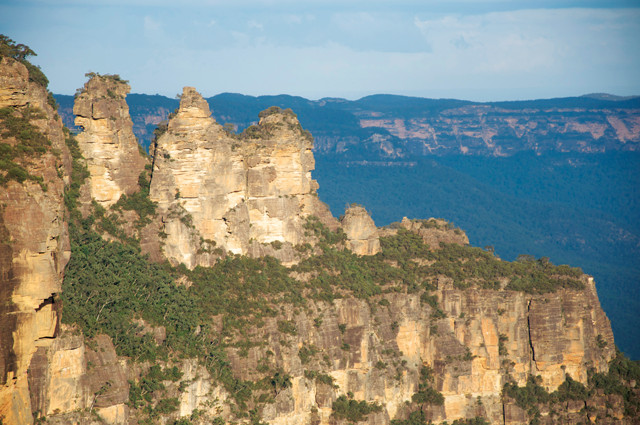
The Three Sisters formation, a triplet of sandstone peaks, as seen from a cable car descending into Jamison Valley. The Blue Mountains get their name from the blue haze that drapes the region. The mist is made up of oil droplets from eucalyptus trees. Credit: ©Meghan Miner
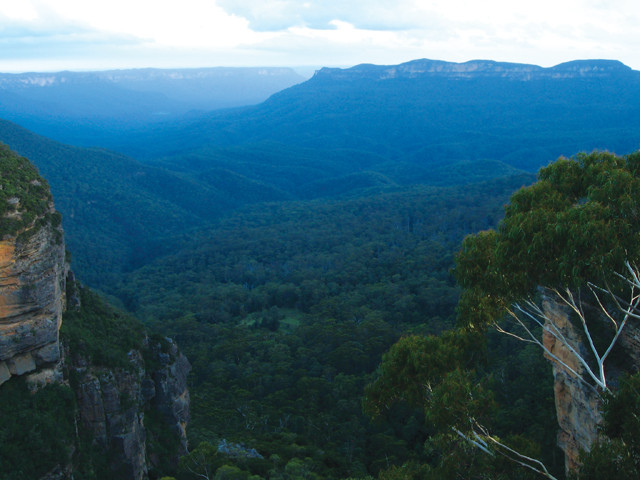
Credit: ©Hector Garcia, Creative Commons Attribution-ShareAlike 2.0 Generic
Australia has a lot to offer when it comes to geology, but you don’t have to venture as far inland as the famed Ayers Rock to see spectacular sights. Sydneysiders have been seeking respite from urban chaos in the nearby Blue Mountains National Park for almost a hundred years. The mountains are known for their sweeping vistas, cool microclimate, wildlife, Aboriginal history and rock formations like the statuesque Three Sisters and the rubble heap of Ruined Castle.
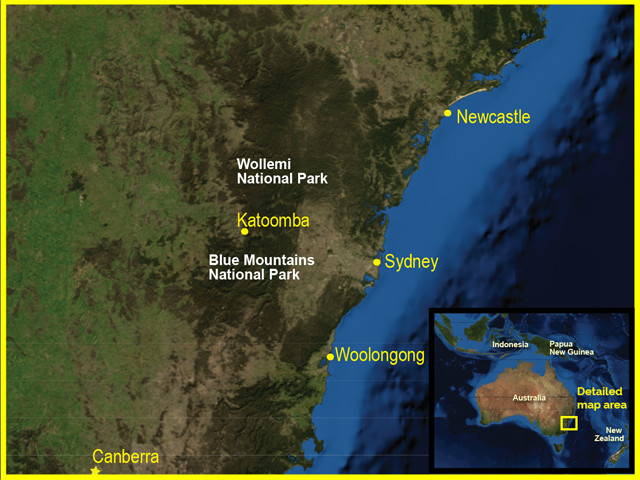
Australia's Blue Mountains area is just 100 kilometers west of Sydney, and can be reached by car or public transportation. Credit: AGI/NASA
Blue Mountains National Park is housed within the Greater Blue Mountains Area, a UNESCO World Heritage Site that covers more than 10,000 square kilometers. A misty bluish haze drapes over the expanse of Jamison Valley, giving the mountains their name. The mist is made up of tiny droplets of oil from the 91 species of eucalyptus trees that grow on the arid escarpments and in the temperate rainforest that blankets the mountain slopes, emitting a spicy, woodsy aroma.
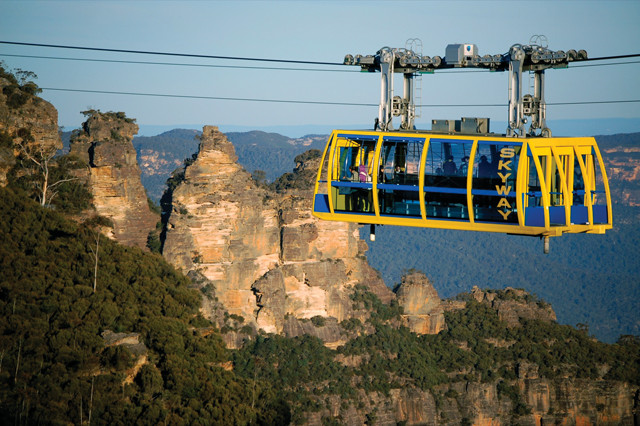
An easy way to experience the Blue Mountains is to ride a Scenic World cable car. Credit: ©Angela Rutherford, Creative Commons Attribution-NonCommercial-NoDerivs 2.0 Generic
Looking like a verdant version of the Utah canyons, the area consists mostly of heavily fractured sandstone cliffs and plateaus. The whole area lies atop 470-million-year-old quartzite. Between 280 million and 250 million years ago, a shallow sea covered the region, and rivers emptying into the sea brought shales, siltstones and mudstones. Then, 250 million to 170 million years ago, the rivers dumped vast amounts of sand that buried the other sedimentary rocks. Later, tectonic forces uplifted the region, and rivers carved deep valleys and created steep cliffs, some as tall as 1,200 meters. The most popular attraction in the Blue Mountains is the Three Sisters formation, a jutting triplet of sandstone peaks that was worn into position by the scouring of wind, rain and rivers — their yellow rocks light up beautifully at sunset.
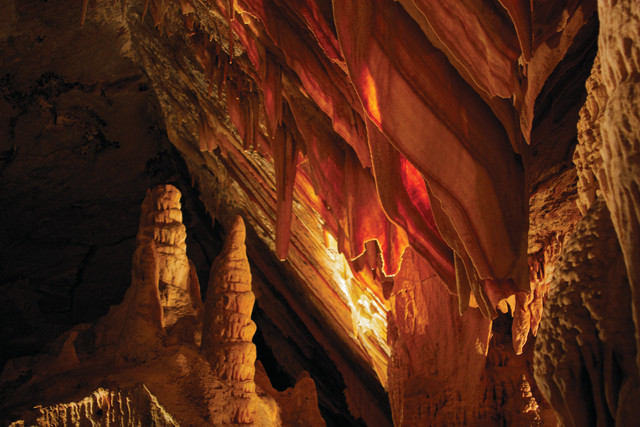
Cave formations inside the Jenolan Caves. Credit: : ©sri_the_quack, Creative Commons Attribution-NonCommercial-NoDerivs 2.0 Generic
Once perceived as forbidding, impenetrable terrain, the Blue Mountains weren’t traversed by European explorers until 1813. Shortly afterward, coal seams — the remnants of vegetation buried 250 million years ago — were discovered interspersed in the shales and sandstone throughout the landscape. The area quickly became populated with miners who left their families to work in the remote regions of the mountains. Coal extraction ended in 1895 due to a banking crisis and the collapse of a major section of the railway line used to transport coal out of the steeply sloping valleys. All that remain of the mining history within the park are a few short sections of single-rail track, a railcar on display outside one of the former frontier towns and mysterious holes in the cliff faces.
Today, the Blue Mountains are much easier to get to than they were a couple of centuries ago, as evidenced by the nearly 3 million people who visit each year. The park is only an hour’s journey west from semitropical Sydney, yet it is a world apart — the elevation and distance from the ocean keep the air cooler year-round, enough to be a snowy retreat in winter. The park is readily accessible by car, bus or train.
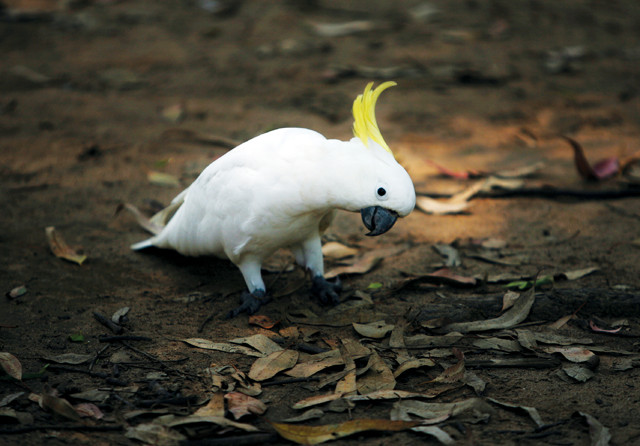
A cockatoo is one of many birds visitors might stumble across in the Blue Mountains. Credit: ©iStockphoto.com/Graham Denholm
Many tourists begin their visit from the outpost towns of Katoomba, Leura or Wentworth Falls, but others choose a flashier entrance through Scenic World in the center of the park, just west of Katoomba. Scenic World, a theme park of sorts, boasts a bar with delicious cupcakes, a railway trolley that takes passengers nose-first down the side of the canyon and, most impressively, a glass-bottomed cable car that glides above Jamison Valley, giving tourists an eye-level view of the Three Sisters.
Despite the high volume of tourist traffic to the Blue Mountains, it is still easy to find solitude along the many hiking routes. And, with nearly 145 kilometers of trail, there are exploratory options for everyone. Katoomba, the largest town in the Blue Mountains, is a great starting point for many of the park’s must-sees. From the town, you can walk or bike around the cliff rims following paths taken by Aboriginal inhabitants thousands of years ago. Or, if you have more time to spend, march down the more than 1,600 steps of the Golden Staircase into the rainforest, and follow a winding path to visit the blocky precipice of the Ruined Castle formation, a site where kerosene shale was mined in the mid-1800s to extract the rock’s oil for lamps.
On the more than five-hour round-trip hike to Ruined Castle, you will clamber over boulders the size of houses calved off the tops of cliffs and perched precariously on their rocky eaves. On the trail, you’ll likely encounter flocks of white golden-crested cockatoos, red parrots and raptors soaring overhead. Be sure to listen for the din of the bellbird echoing in the canyon — the ethereal noise seems more likely to be emitted from a frog or a cricket than a bird. Also rustling in the Jurassic-looking ferns of the forest floor could be an endangered tiger quoll, a carnivorous marsupial, or its prey, the shrew-like marsupial antechinus. If five hours of hiking is not enough and you want to go even further afield, an old horse track, the Six Foot Trail, built in the 1880s, stretches from Katoomba through the Blue Gum Forest to the Jenolan Caves 45 kilometers to the east — long enough to keep you bushwalking for three days each way. The strenuous trail, which climbs 900 meters in elevation, is host to an ultra-marathon in May.
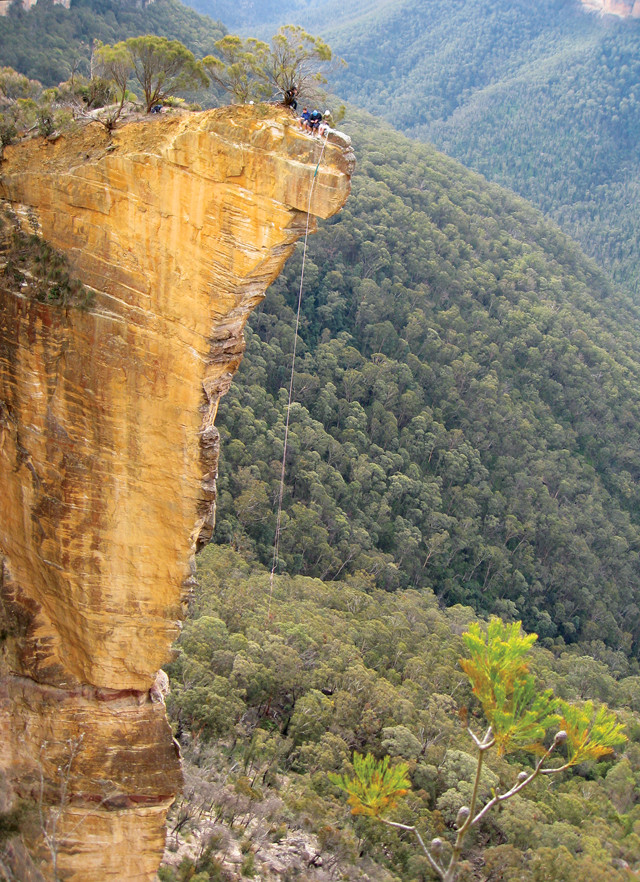
Abseiling, or rappelling down a cliff, is popular in the Blue Mountains. Credit: ©Jeannie Fletcher, Creative Commons Attribution-NonCommercial 2.0 Generic
The Jenolan Caves area includes an accessible and extensive 400-million-year-old cave system that has served as shelter for animals and humans alike. Spelunking, abseiling and adults-only ghost tours are available in and around the caves. The Red Hands Cave is only a three-hour walk from the Glenbrook Causeway near the eastern park town of Glenbrook. Europeans discovered the cave’s handprints — stenciled in red ochre by local Daruk inhabitants 500 to 1,600 years ago — during the search for a missing child in 1913.
If you’re looking for something that will get your adrenaline pumping, adventure activities abound in and around the park, and there are a number of outfitters eager to show you the way. You can go four-wheeling with an eco-operation; try canoeing or whitewater rafting in the nearby rivers; or have a passionate townie show you a few favorite spots to go “bouldering” (rock climbing) in the chasms of the valley.
Back in town after a long day’s hike, nothing hits the spot more than a tall glass of local wine and a giant kangaroo steak with garlic mashed potatoes. Creeping up on menus throughout the continent, and found in several restaurants throughout the Blue Mountains region, kangaroo is an extremely lean red meat. While serving up the national symbol with a side salad may seem sacrilegious — akin to eating bald eagle noodle soup — kangaroo, well-suited to the harsh outback environment, is a sustainable and local protein source.
A trip to the Blue Mountains doesn’t have to end at the park. If you’re itching to go for a drive, the surrounding area is worth exploring as well: Nearly 1,200 kilometers of road called the Greater Blue Mountain Drive link the Blue Mountains National Park to Hunter Valley — the Napa Valley of Australia — and nearby Wollemi National Park. An amazing discovery was made within Wollemi in 1994: A species of tree that survived the breakup of Gondwana, and likely shaded dinosaurs, was found, making it the coelacanth of the plant world. Scientists had thought the wollemi pine had been extinct for millions of years, and today it is one of the rarest species on the planet; only several wild specimens are known to exist. Their location within the park is kept hidden from the public, but wollemi pines are now bred in plant nurseries and are popular adornments alongside the “barbie” on the back porches of Aussies across the country.
To the north of Wollemi is Hunter Valley and towns like Newcastle, Cessnock and Scone, where some of Australia’s famous wines are cultivated in the rolling hills. The area’s loamy soil — filled with rocks and minerals that likely once filled in the valleys and crevices of the Blue Mountains — is an excellent nursery for Shiraz, Cabernet and Semillon grapes. For a sampler of what the region does best, visit vineyards such as the large-scale operation at Lindeman’s Wines and the boutique Pepper Tree, both in the town of Pokolbin. The wine region is flanked by a corridor of mountainous national parks to the west and the Pacific Ocean to the east, a landscape that draws cool ocean air inland, providing an ideal climate for grapes. It’s the scenery, temperature and relaxed vacation vibe, so different from bustling Sydney, that similarly draws tourists inland to the Greater Blue Mountains region time and time again.
© 2008-2021. All rights reserved. Any copying, redistribution or retransmission of any of the contents of this service without the expressed written permission of the American Geosciences Institute is expressly prohibited. Click here for all copyright requests.